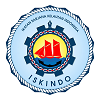Kepadatan dan Pola Distribusi Jenis Kima Lubang (Tridacna crocea Lamark, 1819) di Ekosistem Intertidal pantai Bilik Taman Nasional Baluran
Abstract
ABSTRACK
Borer clam (Tridacna crocea) is species of family Tridacnidae which has not over 15 cm. This species used as a source of protein, their shell are used as souvenirs, and the juvenile of T. crocea are sold as aquascape. Although this species has been cultivated, citizen still exploits is directly in its habitat. This activity is feared to reduce the presence on its population in nature. One of the habitats of this species is in the ecosystem intertidal Bilik coastal Baluran National Park.The purpose of this study was to determine the density and distribution pattern of boring clams in in the ecosystem intertidal Bilik coastal Baluran National Park. The method used is the transect plot method. The density of T. crocea is 0.15 ind/m2 with the type of distribution pattern being clustered. The type of clustered distribution pattern indicated by the value of Id>1, namely Id=30.2182.
Keywords: Kima, Bilik Coast, Baluran National Park
ABSTRAK
Kima lubang (Tridacna crocea) merupakan jenis kima terkecil dari famili Tridacnidae yang memiliki panjang cangkang tidak lebih dari 15 cm. Jenis kima ini dimanfaatkan oleh masyarakat sebagai sumber protein, cangkangnya untuk sovenir, dan anakan dijual hidup sebagai komponen aquascape. Walaupun jenis ini sudah dibudidayakan, namun masyarakat masih melakukan eksploitasi secara langsung di habitatnya. Aktivitas ini dikhawatirkan dapat menurunkan keberadaan populasi ini di alam. Salah satu habitat kima lubang adalah di ekosistem intertidal Pantai Bilik Taman Nasional Baluran. Tujuan dari penelitian ini adalah menentukan kepadatan dan pola distribusi kima lubang di ekosistem intertidal Pantai Bilik Taman Nasional Baluran. Metode yang digunakan untuk menentukan kepadatan dan pola distribusinya adalah metode plot-transek. Kepadatan T. crocea adalah 0.15 ind/m2 dengan tipe pola distribusinya adalah mengelompok. Tipe pola distribusi mengelompok ditunjukkan dengan nilai Id>1 yaitu Id=30.2182.
Kata Kunci: Kima lubang, Tanjung Bilik, Taman Nasional Baluran
Full Text:
PDF (Bahasa Indonesia)References
Borregaard, M. K., Nachman, G., dan Hendrichsen, D. (2014). Spatial Distribution. In Sven Erik Jorgensen and Brian D. Fath (editor-in-Chief), Population Dynamics. Vol [4] of Encyclopedia of Ecology, 5. Pp. [3304-3310]. Oxford: Elsevier.
Braley, R. D. (2009). Giant clam biology and culture. http://aquasearch.com. (Diakses pada tanggal 19 Mei 2021).
Brotowidjoyo, M. D., Tribawono, D., & Mulbyantoro, E. (1999). Pengantar Lingkungan Perairan dan Budidaya Air. Liberty: Yogyakarta.
Cappenberg, H. A. W. (2007). Sebaran dan kepadatan kima (Tridacnidae) di perairan Kepulauan Derawan, Kalimantan Timur. Jurnal Perikanan Universitas Gadjah Mada, 9(2), 220-225.
English, S., Wilkinson, C., & Baker, V. (1997). Survey manual for tropical marine resources. Townsville: Australian Institute of Marine Sciences.
Hamuna, B. R., H. R. Tanjung., H. K. Maury., dan Alianto. 2018. Kajian kualitas air laut dan indeks pencemaran berdasarkan parameter fisika-kimia di perairan distrik Depapre Jayapura. Jurnal Ilmu Lingkungan, 16, 35-43.
Knopp, D. (1964). Giant Clams in a Comprehensive Guide to The Identification and Care of Tridacnidae Clams. Dahne Verlag Ettlingen: German.
Knopp, D. (1995). Giant Clams in a Comprehensive Guide to The Identification and Care of Tridacnidae Clams. Dahne Verlag Ettlingen: German.
Krebs, C. J. (1985). Ecology: The Experimental Analysis of Distribution amd Abundance 2nd Edition. New York: Harper and Row Publishers. Philadephia. 694p.
Krebs, C. J. (2001). Ecology: The Experimental Analysis of Distribution amd Abundance 2nd Edition. New York: Harper and Row Publishers.
Krebs, C. J. (2014). Ecological Methodology 3rd ed. Vancouver: University of British Columbia.
Litaay, M., Gobel, R. B., & Lejab, S. (2007). Kualitas media pemeliharaan larva lola merah dan kima sisik hasil filtrasi bertingkat di hatchery. Ilmu Kelautan: Indonesian Journal of Marine Sciences, 12(1), 24-30.
Marsuki, I. D., Sadarun, B., & Palupi, R. D. (2013). Kondisi Terumbu Karang dan kelimpahan kima di perairan pulau Indo. Jurnal Mina Laut Indonesia, 1(01), 61-72.
McConnaughey, B. H., dan Zottoli. (1983). Introduction to Marine Biology. Mosby Co. St. Louis: Toronto.
Mollusc Specialist Group. (1996). Tridacna crocea. The IUCN Red List of Threatened Species 1996:e.T22135A9361892. https://dx.doi.org/10.2305/IUCN.UK.1996.RLTS.T22135A9361892.en. [Diakses pada 29 December 2020].
Mollusc Specialist Group. (1996). Tridacna crocea. The IUCN Red List of Threatened Species 1996:e.T22135A9361892. https://dx.doi.org/10.2305/IUCN.UK.1996.RLTS.T22135A9361892.en. [Diakses pada 24 Oktober 2020].
Morton, B. (1990). Corals And Their Bivalve Borers – The Evolution Of A Symbiosis. In: Mortom, B. (Ed.),The Bivalvia – Proceedings Of A Memorial Symposium In Honour Of Sir Charles Maurice Yonge, Edinburgh, 1986. Hongkong University Press: Hongkong.
Munro, J. L., & Gwyther, J. (1981, May). Growth rates and maricultural potential of tridacnid clams. In Proceedings of the
th international coral reef symposium (Vol. 2, pp. 633-636).
Neo, M. L., C. C. C. Wabnizt., R. D. Braley., G. A. Heslinga., C. Fauvelot., S. W. Wynsberge., S. Andrefouet., C. Waters., A. S. Tan., E. D. Gomez., M. J. Costello., dan P. A. Todd. (2017). Giant clams (Bivalvia: Cardiidae: Tridacninae): A comprehensive update of species and their distribution, current threats and conservation status. Oceanography and Marine Biology: An Annual Review. 55: 87-388.
Niartiningsih, A., Litaay, M., Suryati, E., & Prasetiawan, I. (2008). Pemeliharaan Juvenil Kima Sisik (Tridacna Squamosa) dan Lola (Trochus Niloticus) secara Monokultur dan Polikultur pada Kedalaman Berbeda di Perairan Pulau Badi, Kabupaten Pangkep. Prosiding Sim-posium Nasional Terumbu Karang II. Hlm, 34-43.
Oceana. (2006). The corals of the Mediterranean. Fondazione Segna. 86 pp.
Odum, E. P. (1998). Dasar-Dasar Ekologi: Edisi Ke Tiga. Gajah Mada University Press: Yogyakarta.
Oktapyani, E., Idiawati, N., & Nurdiansyah, S. I. (2020). Kepadatan dan Pola Distribusi Kima (Tridacna crocea) di Perairan Pulau Kabung Kalimantan Barat. Jurnal Laut Khatulistiwa, 3(3), 91-96.
Rabiyanti, I., Yulianda, F., & Imran, Z. (2019). Analisis Kesesuaian Wisata Bahari Berbasis Kima Di Perairan Negeri Morella, Maluku Tengah. Jurnal Pariwisata, 6(2), 136-140.
Rizal, E. Abdullah, 2013. Pola Distribusi dan Kepadatan Kijing Taiwan (Anadonta woodiana) di Sungai Aworeka Kabupaten Konawe. Jurnal Mina Laut Indonesia, 2(6), 142-153.
Setiawan, H. (2013). Ancaman terhadap populasi kima (Tridacnidacna sp.) dan upaya konservasinya Di Taman Nasional Taka Bonerate. Buletin Eboni, 10(2), 137-147.
Setiawan, R., Wimbaningrum, R., Siddiq, A. M., & Saputra, I. S. (2021). Keanekaragaman Spesies Dan Karakteristik Habitat Kerang Kima (Cardiidae: Tridacninae) Di Ekosistem Intertidal Tanjung Bilik Taman Nasional Baluran. Jurnal Kelautan: Indonesian Journal of Marine Science and Technology, 14(3), 254-262.
Siddiq, A. M., Atmowidi, T., & Qayim, I. (2016). The diversity and distribution of Holothuroidea in shallow waters of Baluran National Park, Indonesia. Biodiversitas Journal of Biological Diversity, 17(1), 55-60.
Smith, R. L. (1990). Ecology and Field Biology 4th Edition. HarperCollins Publishers, Inc., 10 East 53d Street, New York, NY 10022: United States of America.
Soegianto, A. (1994). Ekologi Kuantitatif. Penerbit Usaha Nasional: Surabaya.
Suin, N. M. (2003). Ekologi Populasi. Universitas Andalas: Padang.
Susetiono, (2004). Fauna Padang Lamun Tanjung Merah Selat Lembeh. Jakarta: Pusat Penelitian Oseanografi, LIPI.
Susiana. A. Niartiningsih., M. A. Amran., dan Rochmady. (2017). Kesesuaian lokasi untuk restocking kima Tridacnidae di Kepulauan Spermonde. Jurnal Ilmu dan Teknologi Kelautan Tropis, 9(2), 475-490.
UNEP-WCMC (Comps.). (2020). Checklist of CITES species – CITES Identif ication Manual. CITES Secretariat, Genev a, Switzerland, and UNEPWCMC, Cambridge, United Kingdom. [Diakses pada 19 Oktober 2020].
UNEP-WCMC (Comps.). 2020. Checklist of CITES species – CITES Identification Manual. CITES Secretariat, Geneva, Switzerland, and UNEPWCMC, Cambridge, United Kingdom. [Diakses pada 19 Oktober 2020].
Yasin, Z., & Tan, S. H. (2000). Quantitative and qualitative effects of light on the distribution of giant clams at the Johore Islands in South China Sea. Phuket Marine Biological Center Special Publications, 21(1), 113-118.
DOI: https://doi.org/10.21107/jk.v15i3.14484
Refbacks
- There are currently no refbacks.

This work is licensed under a Creative Commons Attribution 4.0 International License.

Jurnal Kelautan by Program Studi Ilmu Kelautan is licensed under a Creative Commons Attribution 4.0 International License.
Published by: Department of Marine Sciences, Trunojoyo University of Madura













